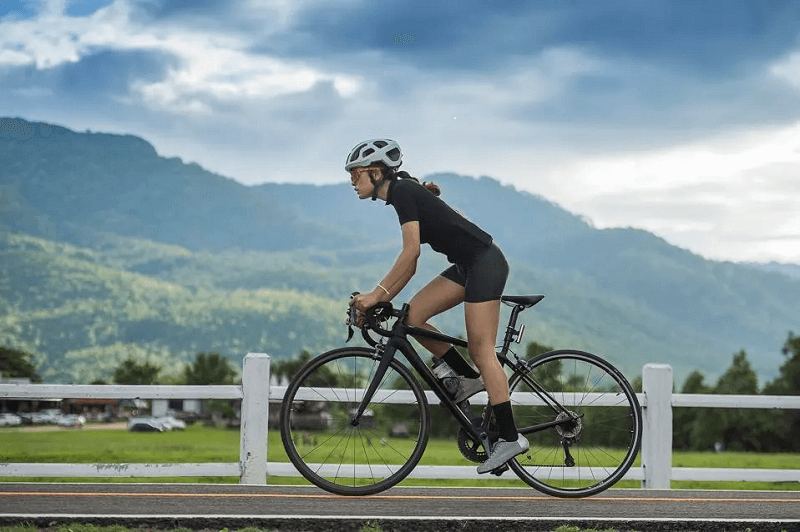Radfahren ist eine wunderbare Aktivität, die zahlreiche Vorteile bietet, Von der körperlichen Fitness bis zur Erkundung der Natur. Jedoch, ein angenehmes und sicheres Radfahrenerlebnis haben, Die Auswahl der richtigen Kleidung ist entscheidend. Bei ystar, Wir verstehen die Wichtigkeit des richtigen Fahrradbekleidung, Und dieser Leitfaden bietet Ihnen wertvolle Tipps zum Anziehen für verschiedene Wetterbedingungen und den Einstieg als Anfänger.

Für Anfänger: Beginnen Sie mit den Grundlagen
Wenn Sie neu im Radfahren sind, Es ist nicht nötig, sofort auf einem vollständigen Radschrank zu verzichten. Kurz, Gelegenheitsfahrten in Ihrer Nachbarschaft, Ihre täglichen Kleidung kann gut funktionieren. Aber denken Sie an ein paar Dinge. Entscheiden Sie sich für bequem, Feuchtigkeits-Wicking-Stoffe wie Baumwolle oder leichte synthetische Mischungen. Diese Materialien tragen dazu bei, Sie trocken zu halten, indem Sie Schweiß von Ihrer Haut wegziehen, Verhindern Sie dieses unangenehme feuchte Gefühl während der Fahrten.
Es ist auch wichtig, Baggy -Kleidung zu vermeiden. Lose sitzende Kleidungsstücke können in der Kette oder den Zahnrädern Ihres Fahrrads gefangen werden, Ein Sicherheitsrisiko darstellen. Ein gut angepasster Outfit reduziert nicht nur diese Gefahr, sondern macht Ihre Fahrt auch komfortabler. Und vergessen Sie niemals das wichtigste Stück Sicherheitsausrüstung – ein Helm. Egal wie kurz Ihre Fahrt ist, Es ist nicht verhandelbar, einen ordnungsgemäß angepassten Helm zu tragen. Es könnte Ihr Leben im Falle eines Unfalls retten.
Während normale Kleidung ein Ausgangspunkt sein kann, Wenn Sie Fortschritte machen und längere Fahrten machen, Sie werden ihre Einschränkungen bemerken. Sie können Feuchtigkeit nicht gut bewältigen, Schaffen Sie unnötige Windwiderstand, und fehlen die Sichtbarkeitsmerkmale, die spezielle Radkleidung hat. Dann ist es Zeit, in eine Investition in dedizierte Fahrradausrüstung in Betracht zu ziehen.
Die Einzigartigkeit von Radfahrenkleidung
Radfahrkleidung ist mit spezifischen Funktionen ausgelegt, um Ihr Radfahrenerlebnis zu verbessern. Nehmen Sie Fahrradkleidung, Zum Beispiel. Diese formsteuenden Tops bestehen aus Feuchtigkeits-Wicking-Materialien, die sich von Ihrer Haut fernhalten, Verhinderung von Scheuern und Beschwerden verhindern. Sie kommen oft mit einem Reißverschluss in voller Länge, So können Sie die Belüftung leicht einstellen. Wenn Sie sich während Ihrer Fahrt heiß fühlen, Entpacken Sie einfach das Trikot, um frische Luft hereinzulassen.
Radfahrer sind ein weiteres wesentliches Ausrüstungsstück. Für kühlere oder feuchtere Bedingungen, Sie liefern Wind- und Wasserbeständigkeit, Halten Sie Sie warm und trocken. Einige Jacken sind sogar mit atmungsaktiven Membranen ausgelegt, Sie haben also nicht überhitzt, während Sie vor den Elementen geschützt bleiben. Westen, oder ärmellose Tops, sind großartig für das Übergangswetter. Sie fügen eine zusätzliche Isolationsschicht hinzu, ohne die Armbewegung einzuschränken, Geben Sie Ihnen die Flexibilität, die Sie beim Radfahren benötigen.
Die untere Kleidung der unteren Halbzeit spielt auch eine bedeutende Rolle. Gepolsterte Fahrradshorts sind ein Spielveränderer für lange Fahrten. Die Polsterung reduziert den Druck auf empfindliche Bereiche, Beschwerden und Scheuern verhindern. Bib -Shorts, die an einem haltenderähnlichen Top befestigt sind, bieten noch mehr Komfort und Berichterstattung. Sie bleiben besser an Ort und Stelle als normale Shorts, Beseitigen Sie die Notwendigkeit, sie während Ihrer Fahrt ständig anzupassen. Für kälteres Wetter, Radfahrerhosen sind ein Muss. Suchen Sie nach solchen mit winddichten und wasserdichten Merkmalen, um Sie vor Kälte und Regen zu schützen.

Anziehung für verschiedene Jahreszeiten
Sommerradfahren
Sommerradfahren ist eine großartige Möglichkeit, das warme Wetter zu genießen, Es ist jedoch wichtig, die richtige Kleidung auszuwählen, um cool zu bleiben. Leicht, atmungsaktive Stoffe sind der Schlüssel. Kurzarm-Trikots und Shorts sind ideal für heiße Sommertage. Sie lassen Luft um Ihren Körper umzumachen, helping to keep you cool. Stellen Sie sicher, Da dies bei langen Fahrten zusätzlichen Komfort bietet.
Vergessen Sie nicht, Sonnenschutzmittel zu tragen, um Ihre Haut vor den schädlichen UV -Strahlen der Sonne zu schützen. Auch an bewölkten Tagen, UV -Strahlen können Ihre Haut immer noch beschädigen. Eine gute Sonnenbrille ist ebenfalls unerlässlich. Sie schützen Ihre Augen vor der Sonne, Wind, und Trümmer. Suchen Sie nach Sonnenbrillen mit Anti-Fog-Funktionen, Da dies verhindert, dass Ihre Sicht während Ihrer Fahrt beeinträchtigt wird.
Winterradfahren
Winterradfahren kann eine Herausforderung sein, Aber mit der richtigen Kleidung, Es kann auch eine großartige Möglichkeit sein, aktiv zu bleiben. Schichtung ist der Schlüssel zum Anziehen für das Winterradfahren. Beginnen Sie mit einer Grundschicht aus einem Feuchtigkeits-Wicking-Material. Diese Schicht zieht Schweiß von Ihrer Haut weg, Halten Sie Sie trocken. Über die Basisschicht, Tragen Sie ein Thermaltrikot oder eine Jacke zur Wärme. Suchen Sie nach Jacken mit winddichten und wasserdichten Merkmalen, um Sie vor Kälte und Regen zu schützen.
Für deine Beine, Tragen Sie warme Lätzchenstrumpfhose oder thermische Leggings. Diese werden Ihre Beine warm und vor den Elementen geschützt. Vergessen Sie nicht, thermische Socken und Winterschuhe oder Überschüsse zu tragen, um Ihre Füße warm zu halten. Handschuhe sind auch für das Winterradfahren von wesentlicher Bedeutung. Suchen Sie nach Handschuhen mit einer wasserdichten und winddichten Außenschicht und einer warmen Futter. Ein warmer Hut oder eine Kappe hilft auch, Ihren Kopf warm zu halten.
Feder- und Herbstradfahren
Frühling und Herbst sind Übergangssaisonen, und das Wetter kann unvorhersehbar sein. Deshalb ist es wichtig, sich in Schichten zu kleiden. Beginnen Sie mit einer Basisschicht, wie eine Langarm- oder Kurzarm-Lichtbasisschicht. Über die Basisschicht, Tragen Sie ein Fahrradtrikot oder eine Jacke. Sie können auch eine leichte Windweste oder Jacke zum zusätzlichen Schutz hinzufügen.
Für deine Beine, Tragen Sie Fahrradshorts mit Kniewärmer oder Unterhosen. Auf diese Weise können Sie die Abdeckungsmenge je nach Temperatur einstellen. Vergessen Sie nicht, warme Socken und Fahrradhandschuhe zu tragen. Ein Stirnband oder eine Kappe hilft auch, Ihren Kopf und Ihre Ohren warm zu halten.
Zusätzliche Tipps
- Sichtweite: Egal in der Saison, Sichtbarkeit ist für die Fahrradsicherheit von entscheidender Bedeutung. Suchen Sie nach Radkleidung mit reflektierenden Elementen oder leuchtenden Farben. Dies wird Sie für Autofahrer sichtbarer machen, vor allem unter Bedingungen bei schlechten Lichtverhältnissen.
- Fit: Stellen Sie sicher, dass Ihre Fahrradkleidung richtig passt. Zu eng mit Kleidung können Ihre Bewegung einschränken, während zu locker Kleidung Windwiderstand erzeugen kann.
- Qualität: Investieren Sie in hochwertige Fahrradkleidung. Es kann im Voraus mehr kosten, aber es wird länger dauern und eine bessere Leistung liefern.
- Pflege: Befolgen Sie die Pflegeanweisungen auf Ihrer Fahrradkleidung, um sie in gutem Zustand zu halten. Waschen Sie es in einem sanften Zyklus und vermeiden Sie die Verwendung von Stoffweichmachern, Da können sie die Feuchtigkeits-Wicking-Eigenschaften des Stoffes beschädigen.

Abschließend, Die Auswahl der richtigen Fahrradkleidung ist für ein komfortables und sicheres Fahrradlebnis von entscheidender Bedeutung. Durch Folgen dieser Tipps, you can dress appropriately for different weather conditions and start your cycling journey on the right foot. Bei ystar, Wir sind bestrebt, Ihnen dabei zu helfen, die perfekte Fahrradkleidung zu finden, um Ihre Fahrten zu verbessern. Also, sich aufrühren, bleib sicher, Und genießen Sie die wundervolle Welt des Radfahrens!



